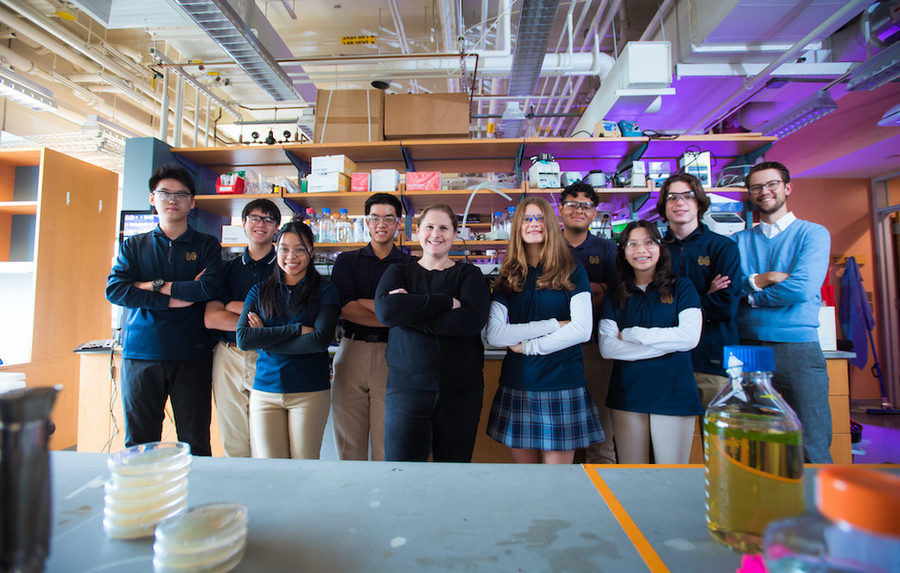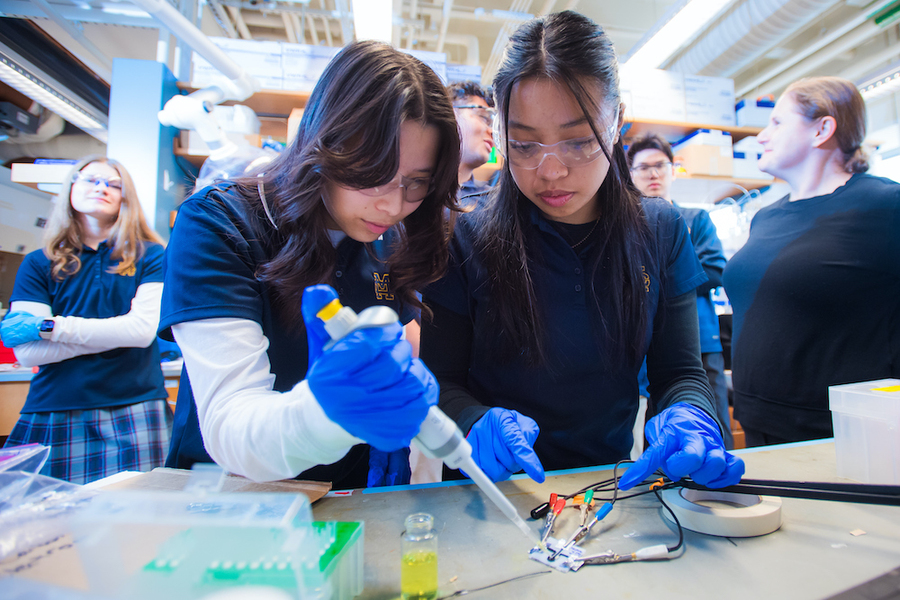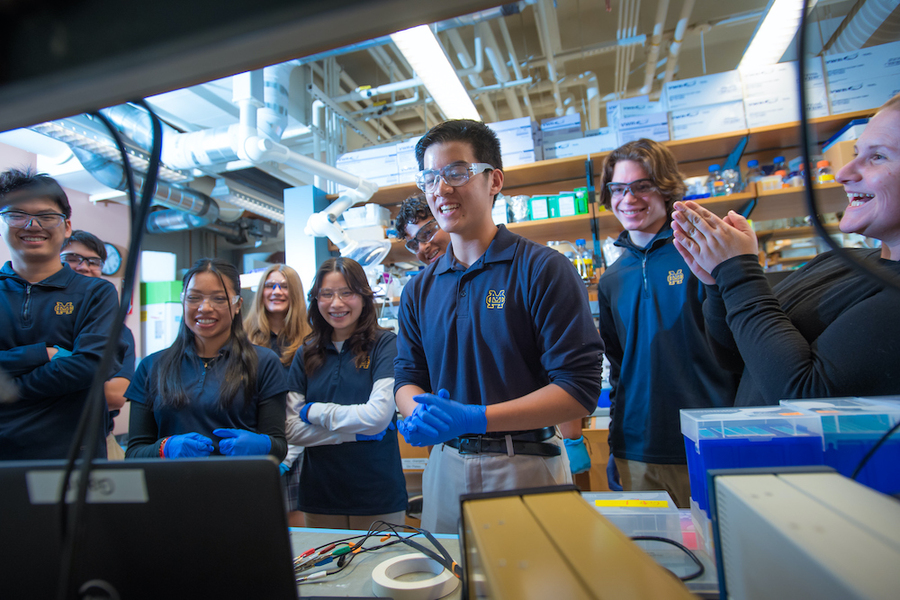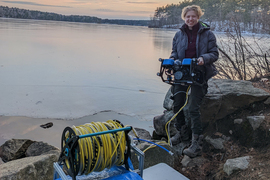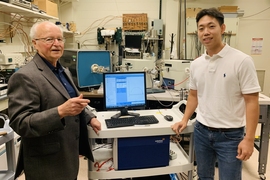In a lab on the fourth floor of MIT’s Building 56, a group of Massachusetts high school students gathered around a device that measures conductivity.
Vincent Nguyen, 15, from Saugus, thought of the times the material on their sample electrode flaked off the moment they took it out of the oven. Or how the electrode would fold weirdly onto itself. The big fails were kind of funny, but discouraging. The students had worked for a month, experimenting with different materials, and 17-year-old Brianna Tong of Malden wondered if they’d finally gotten it right: Would their electrode work well enough to power a microbial fuel cell?
The students secured their electrode with alligator clips, someone hit start, and the teens watched anxiously as the device searched for even the faintest electrical current.
Capturing electrons from bacteria
Last July, Tong, Nguyen, and six other students from Malden Catholic High School commuted between the lab of MIT chemical engineer Ariel L. Furst and their school’s chemistry lab. Their goal was to fashion electrodes for low-cost microbial fuel cells — miniature bioreactors that generate small amounts of electricity by capturing electrons transferred from living microbes. These devices can double as electrochemical sensors.
Furst, the Paul M. Cook Career Development Professor of Chemical Engineering, uses a mix of electrochemistry, microbial engineering, and materials science to address challenges in human health and clean energy. “The goal of all of our projects is to increase sustainability, clean energy, and health equity globally,” she says.
Electrochemical sensors are powerful, sensitive detection and measurement tools. Typically, their electrodes need to be built in precisely engineered environments. “Thinking about ways of making devices without needing a cleanroom is important for coming up with inexpensive devices that can be deployed in low-resource settings under non-ideal conditions,” Furst says.
For 17-year-old Angelina Ang of Everett, the project illuminated the significance of “coming together to problem-solve for a healthier and more sustainable earth,” she says. “It made me realize that we hold the answers to fix our dying planet.”
With the help of a children’s toy called Shrinky Dinks, carbon-based materials, nail polish, and a certain smelly bacterium, the students got — literally — a trial-by-fire introduction to the scientific method. At one point, one of their experimental electrodes burst into flames. Other results were more promising.
The students took advantage of the electrical properties of a bacterium — Shewanella oneidensis — that’s been called nature’s microscopic power plant. As part of their metabolism, Shewanella oneidensis generate electricity by oxidizing organic matter. In essence, they spit out electrons. Put enough together, and you get a few milliamps.
To build bacteria-friendly electrodes, one of the first things the students did was culture Shewanella. They learned how to pour a growth medium into petri dishes where the reddish, normally lake-living bacteria could multiply. The microbes, Furst notes, are a little stinky, like cabbage. “But we think they’re really cool,” she says.
With the right engineering, Shewanella can produce electric current when they detect toxins in water or soil. They could be used for bioremediation of wastewater. Low-cost versions could be useful for areas with limited or no access to reliable electricity and clean water.
Next-generation chemists
The Malden Catholic-MIT program resulted from a fluke encounter between Furst and a Malden Catholic parent.
Mary-Margaret O’Donnell-Zablocki, then a medicinal chemist at a Kendall Square biotech startup, met Furst through a mutual friend. She asked Furst if she’d consider hosting high school chemistry students in her lab for the summer.
Furst was intrigued. She traces her own passion for science to a program she’d happened upon between her junior and senior years in high school in St. Louis. The daughter of a software engineer and a businesswoman, Furst was casting around for potential career interests when she came across a summer program that enlisted scientists in academia and private research to introduce high school students and teachers to aspects of the scientific enterprise.
“That’s when I realized that research is not like a lab class where there’s an expected outcome,” Furst recalls. “It’s so much cooler than that.”
Using startup funding from an MIT Energy Initiative seed grant, Furst developed a curriculum with Malden Catholic chemistry teacher Seamus McGuire, and students were invited to apply. In addition to Tong, Ang, and Nguyen, participants included Chengxiang Lou, 18, from China; Christian Ogata, 14, of Wakefield; Kenneth Ramirez, 17, of Everett; Isaac Toscano, 17, of Medford; and MaryKatherine Zablocki, 15, of Revere and Wakefield. O’Donnell-Zablocki was surprised — and pleased — when her daughter applied to the program and was accepted.
Furst notes that women are still underrepresented in chemical engineering. She was particularly excited to mentor young women through the program.
A conductive ink
The students were charged with identifying materials that had high conductivity, low resistance, were a bit soluble, and — with the help of a compatible “glue” — were able to stick to a substrate.
Furst showed the Malden Catholic crew Shrinky Dinks — a common polymer popularized in the 1970s as a craft material that, when heated in a toaster oven, shrinks to a third of its size and becomes thicker and more rigid. Electrodes based on Shrinky Dinks would cost pennies, making it an ideal, inexpensive material for microbial fuel cells that could monitor, for instance, soil health in low- and middle-income countries.
“Right now, monitoring soil health is problematic,” Furst says. “You have to collect a sample and bring it back to the lab to analyze in expensive equipment. But if we have these little devices that cost a couple of bucks each, we can monitor soil health remotely.”
After a crash course in conductive carbon-based inks and solvent glues, the students went off to Malden Catholic to figure out what materials they wanted to try.
Tong rattled them off: carbon nanotubes, carbon nanofibers, graphite powder, activated carbon. Potential solvents to help glue the carbon to the Shrinky Dinks included nail polish, corn syrup, and embossing ink, to name a few. They tested and retested. When they hit a dead end, they revised their hypotheses.
They tried using a 3D printed stencil to daub the ink-glue mixture onto the Shrinky Dinks. They hand-painted them. They tried printing stickers. They worked with little squeegees. They tried scooping and dragging the material. Some of their electro-materials either flaked off or wouldn’t stick in the heating process.
“Embossing ink never dried after baking the Shrinky Dink,” Ogata recalls. “In fact, it’s probably still liquid! And corn syrup had a tendency to boil. Seeing activated carbon ignite or corn syrup boiling in the convection oven was quite the spectacle.”
“After the electrode was out of the oven and cooled down, we would check the conductivity,” says Tong, who plans to pursue a career in science. “If we saw there was a high conductivity, we got excited and thought those materials worked.”
The moment of truth came in Furst’s MIT lab, where the students had access to more sophisticated testing equipment. Would their electrodes conduct electricity?
Many of them didn’t. Tong says, “At first, we were sad, but then Dr. Furst told us that this is what science is, testing repeatedly and sometimes not getting the results we wanted.” Lou agrees. “If we just copy the data left by other scholars and don’t collect and figure it out by ourselves, then it is difficult to be a qualified researcher,” he says.
Some of the students plan to continue the project one afternoon a week at MIT and as an independent study at Malden Catholic. The long-term goal is to create a field-based soil sensor that employs a bacterium like Shewanella.
By chance, the students’ very first electrode — made of graphite powder ink and nail polish glue — generated the most current. One of the team’s biggest surprises was how much better black nail polish worked than clear nail polish. It turns out black nail polish contains iron-based pigment — a conductor. The unexpected win took some of the sting out of the failures.
“They learned a very hard lesson: Your results might be awesome, and things are exciting, but then nothing else might work. And that’s totally fine,” Furst says.
This article appears in the Winter 2023 issue of Energy Futures, the magazine of the MIT Energy Initiative.
